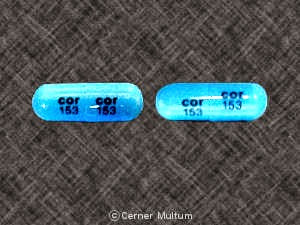CLINDAMYCIN VAGINAL
(klin da MYE sin) Brand: Cleocin Vaginal










What is the most significant information I must know about clindamycin vaginal?
• Do not use this medicine if you are allergic to clindamycin or lincomycin (Bactramycin, L-Mycin, Lincocin), or if you have an intestinal mess such as colitis or Crohn's disease.
• Till using clindamycin vaginal, speak your doctor if you have ever had severe diarrhea caused by using an antibiotic.
• Use this medicine for the entire length of time predesigned by your doctor. Your symptoms may get better till the infection is completely treated. This medicine will not treat a vaginal yeast infection.
• Antibiotic medicines can reason diarrhea, which may be a sign of a new infection. If you have diarrhea that is watery or has blood in it, call your doctor. Do not use any medication to stop the diarrhea unless your doctor has told you to.
• If you need to have any type of surgery, speak the surgeon onward of time that you are using clindamycin vaginal. You may need to stop using the medication for a short time.
What is clindamycin vaginal?
• Clindamycin is an antibiotic that fights bacteria in the body.
• Clindamycin vaginal is used to treat vaginal infections caused by bacteria.
• Clindamycin vaginal may also be used for purposes another than those listed in this medicine guide.
What must I discuss with my healthcare provider till using clindamycin vaginal?
• Do not use this medicine if you are allergic to clindamycin or lincomycin (Bactramycin, L-Mycin, Lincocin, or if you have
· colitis, Crohn's malady, or another intestinal mess; or
· if you have ever had severe diarrhea caused by using an antibiotic.
• Till using clindamycin vaginal, speak your doctor if you are allergic to any drugs, or if you have any type of intestinal mess. You may not be able to use clindamycin vaginal, or you may need a dosage adjustment or particular trials during treatment.
• FDA pregnancy category B. This medicine is not expected to be deleterious to an unborn child. Speak your doctor if you are pregnant or plan to become pregnant during treatment. Clindamycin vaginal is sometimes used in pregnant women.
• Clindamycin vaginal cream may contain mineral oil, which can weaken the latex rubber in a condom. This could result in breaking of the condom, and an unintended pregnancy could result. Avoid using a condom as a birth control method while you are using clindamycin vaginal and for at least 72 hours (3 days) after your treatment ends.
• Clindamycin vaginal can pass into breast milk and may harm a nursing child. Do not use this medicine without telling your doctor if you are breast-feeding a baby.
How must I use clindamycin vaginal?
• Use this medicine exactly as it was predesigned for you. Do not use the medicine in larger amounts, or use it for longer than recommended by your doctor. Follow the directions on your prescription label.
• This medicine comes with patient instructions for safety and effective use. Follow these directions carefully. Ask your doctor or pharmacist if you have any questions.
• Apply the vaginal cream only with the disposable applicators provided with the medication. Use a new applicator every time you apply the cream, and then throw the applicator away. Do not clean or reuse a disposable applicator.
• Clindamycin vaginal is generally used at bedtime for 3 to 7 nights in a row.
• This medicine can reason burning or irritation if you accidentally get it in your eyes. If this does happen, rinse with plenty of cold water.
• Use this medicine for the entire length of time predesigned by your doctor. Your symptoms may get better till the infection is completely treated. This medicine will not treat a vaginal yeast infection.
• If you need to have any type of surgery, speak the surgeon onward of time that you are using clindamycin vaginal. You may need to stop using the medication for a short time.
• Call your doctor if your symptoms get worse, or if they do not improve after using this medication for 7 nights in a row.
• Store clindamycin vaginal at room temperature away from moisture and heat.
What happens if I miss a dose?
• Use the missed doze as soon as you remember. If it is nearly time for your following doze, skip the missed doze and use the medication at your following regularly scheduled time. Do not use extra medication to create up the missed doze. It is excellent to use the medicine only at bedtime, or while you will be resting or lying down.
What happens if I overdose?
• Search abnormal medical attention if you think you have used too many of this medicine.
• Symptoms of a clindamycin vaginal overdose may include diarrhea that is watery or bloody.
What must I avoid while using clindamycin vaginal?
• Avoid having sexual intercourse or using vaginal commodity such as tampons, lubricants, or douches while you are using this medication.
• Antibiotic medicines can reason diarrhea, which may be a sign of a new infection. If you have diarrhea that is watery or has blood in it, call your doctor. Do not use any medication to stop the diarrhea unless your doctor has told you to.
What are the possible side effects of clindamycin vaginal?
• Get abnormal medical help if you have any of these signs of an allergic reaction: hives; difficulty breathing; swelling of your person, lips, tongue, or throat.
• Stop using clindamycin vaginal and call your doctor at once if you have diarrhea that is watery or bloody.
• Hold using clindamycin vaginal and conversation to your doctor if you have any of these smaller serious side effects:
· mild nausea or stomach pain;
· constipation, gas;
· vaginal itching, discharge, or pain; or
· changes in your menstrual periods; or
· mild skin rash or itching.
• Side effects another than those listed here may also occur. Conversation to your doctor about any side effect that seems unusual or that is especially bothersome. You may message side effects to FDA at 1-800-FDA-1088.
What another drugs will affect clindamycin vaginal?
• There may be another drugs that can affect clindamycin vaginal. Speak your doctor about all the prescription and over-the-counter medications you use. This includes vitamins, minerals, herbal commodity, and drugs predesigned by another doctors. Do not start using a new medicine without telling your doctor.
Where can I get more information?
• Your pharmacist has information about clindamycin vaginal written for health professionals that you may read.
Remember, hold this and all another medicines out of the reach of children, never share your medicines with others, and use this medicine only for the indication prescribed.
Disclaim: Each effort has been made to ensure that the information provided by Cerner Multum, Inc. ('Multum') is accurate, up-to-date, and complete, but no guarantee is made to that effect. Drug information contained herein may be time sensitive. Multum information has been compiled for use by healthcare practitioners and consumers in the United States and therefore Multum does not warrant that uses external of the United States are appropriate, unless specifically indicated otherwise. Multum's drug information does not endorse drugs, diagnose patients or recommend therapy. Multum's drug information is an informational resource designed to assist licensed healthcare practitioners in caring for their patients and/or to serve consumers viewing this service as a supplement to, and not a substitute for, the expertise, skill, knowledge and judgment of healthcare practitioners. The absence of a warning for a given drug or drug combination in no way must be construed to indicate that the drug or drug combination is safety, effective or appropriate for any given patient. Multum does not assume any responsibility for any aspect of healthcare administered with the help of information Multum provides. The information contained herein is not intended to cover all possible uses, directions, precautions, warnings, drug interactions, allergic reactions, or adverse effects. If you have questions about the drugs you are taking, check with your doctor, nurse or pharmacist.